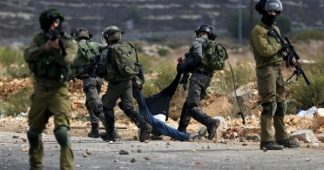Article published Wednesday, October 22, 2003
Reminders of 1967 are never far away for those in the Song Ve Valley of Vietnam
Hands trembling, she prayed quietly to the uncle who stumbled upon the soldiers so long ago.
Like so many others, he didn’t survive.
Torn by bullets, the body of Dao Hue was found near the river, a mile from the hut he shared with his niece.
The elderly carpenter was one of the first civilians killed by Tiger Force soldiers in a chain of atrocities that forever changed the Song Ve Valley.
The reminders are everywhere: the unmarked graves along the trails, the bend in the river where the men tried to hide from the soldiers, the rice paddy where the bodies were pulled from the mud.
The stories of the troops firing on unarmed civilians in the summer of 1967 are told in schools, communal centers, and prayer services.
Elderly villagers still describe the Army helicopters dropping leaflets, warning the people to go to relocation camps.
Within days, the soldiers wearing the “chicken patches” – the eagle insignia of the 101st Airborne Division worn by Tiger Force – were rounding up families, seizing their food, and torching their huts.
Over the next six weeks, platoon members killed an untold number who refused to go to the decrepit camps, according to a Blade investigation based on Army records and interviews with more than 100 former Tiger Force soldiers and Vietnamese villagers.
To this day, the shooting deaths evoke anger in those who survived the rampage – with some people calling for the former soldiers to be prosecuted.
“The people who carried out these crimes need to be held responsible,” said Vo Thanh Tien, 50, a local provincial official. “They made it very hard for the people who live along the river.”
In seven months of atrocities – May to November, 1967 – a third took place in this valley in Quang Ngai province, a place so remote and timeless the effects are visible decades later.
Many villagers said they’re still paying for the actions of soldiers who broke the rules of war.
“Even after 30 years, it hurts,” said Ms. Tam, now 70, pointing to her stomach. “I ask myself why my uncle had to die. He did nothing wrong.”
The details of his death are still recalled by people in the Hanh Tin hamlet, a cluster of huts and concrete homes with clay roofs where people share narrow dirt roads with water buffalo.
His grave is passed every day by farmers heading to the rice paddies and children walking to school.
Older villagers say they still don’t understand why the man who helped build their homes was slain. “He didn’t do anything,” said Lu Thuan, 67. “They just shot him. No reason. Nothing.”
Villagers continue to talk about `the missing people’
The fog covering the Song Ve Valley had burned away, revealing a swath of rice paddies.
Vo Tai Can, 12, and his two friends were no longer safe.
The three had been trying to hide from the soldiers to avoid being sent to a relocation camp.
Now they were in sight of Tiger Force.
Within minutes, they were captured, the boy taken away by helicopter, his companions – partially blind men in their 20s – led to a rice paddy.
Without warning, the men were executed, Army records state, their bodies tossed into open graves.
The two civilians were among the many people killed in the valley for failing to abide by the Army’s relocation order.
Thirty-six years later, no one knows how many were executed by platoon members for not leaving. Of the estimated 5,000 people who lived in the valley in 1967, some fled to the mountains, while others were forced to live in the camps.
Hundreds remain unaccounted for today.
Villagers still talk about the “missing people” – their names and where they lived, but their whereabouts are still a mystery.
It wasn’t until the war ended that villagers began to realize that many would never return.
One was Vo Tai Can.
Shortly after his capture, the boy with the wide grin who often played along the dirt roads of Van Xuan village was sent to a relocation camp, said Nguyen Dam, 66, a rice farmer. But after the war, he was never seen in the valley.
Like a member of the lost generation, “he was just gone,” Mr. Nguyen said. “We have no idea where he went.”
Some said he was forced to live in the Nghia Hanh camp, enclosed by concrete walls and razor wire.
Mr. Nguyen said he may have been the last person in the valley to see the boy as he was being carried away in the helicopter but couldn’t do anything to help.
In fear of being killed, Mr. Nguyen escaped to the mountains.
Attack on farmers defines war for many
In homes scattered across the valley are death certificates bearing the names of people killed by the Tiger Force soldiers in the summer of 1967.
For Kieu Trac, the paper is a reminder of his father’s last day.
He was among 10 elderly farmers who were toiling in a rice paddy when platoon soldiers opened fire, killing four.
Years later, the attack on July 28 continues to define the war years for the people of the Song Ve Valley.
Every year, relatives pray for the victims at Buddhist ceremonies and light incense and candles at their graves.
Villagers say the assault has become the most recognized atrocity of 1967 – one they still talk about when the topic of the war arises.
The attack marked the last time anyone would openly grow crops during the war, say villagers.
But more than farming, it changed lives.
Suddenly, Kieu Trac became the head of the family – in charge of caring for his mother, four siblings, and his own young family.
“Life became harder,” said Mr. Kieu, now 72.
In one brutal attack, he said, he was forced to accept responsibilities he shoulders to this day.
Every year, he gathers his family – 16 members living in the same concrete and bamboo home – to remind them of the man who taught him to farm.
Kieu Cong was a gentle provider who spent long days in the fields, with little time to share with his five children. But when he did come home, he often sat with his son and gave advice about living a moral life.
“He told me not to steal,” he said, his eyes moistening. “He encouraged me to avoid the bad things in life.”
His father was not a part of the guerrilla movement nor did he take sides in the war, he said.
Staring pensively at the altar with incense in his cramped living room, he pointed to his father’s name on the wall, and said, “He just wanted to farm.”
Rampage of 1967 changed lives forever
In the valley, part of a generation is growing up without parents and grandparents.
In nearly every home, there’s a story.
The soldiers shooting farmers in the rice field. The soldiers shooting the village elder at the edge of the hamlet. The soldiers shooting the old man near the river bend.
“There were so many people dying,” said Vo Thanh Tien, a communal leader.
That’s why he and others say the U.S. and Vietnamese governments should investigate the atrocities committed in the valley nearly four decades ago.
Mr. Vo and others said they want to know why the Army let its troops lose control, especially among noncombatants who took no side in the war.
Unlike other areas of Quang Ngai province, the valley – connected to the coast by twisting dirt roads – was not a center of rebellion, say Vietnamese historians. For hundreds of years, the fertile basin was settled by farmers who grew rice in one of the most productive regions of the nation.
“These are people who did nothing,” said Lu Thuan, who hid in the mountains to avoid being shot.
Mr. Vo said the attacks on civilians between June and August, 1967, were war crimes that Americans never publicly acknowledged.
“We think the U.S. government should take responsibility and look back at what happened during the war to these people,” he said.
Records in the National Archives – mostly 1967 battalion reports – do not indicate the villagers in Song Ve Valley were hostile to U.S. troops.
Former Tiger Force platoon members said their mission was to stop the farming in the Song Ve to deprive the Viet Cong of a potential food source.
During a 41/2-year Army investigation of Tiger Force atrocities – from 1971 to 1975 – 14 soldiers said they witnessed or participated in the killings of at least nine unarmed villagers in the valley. But those are just the documented cases.
In recent interviews with The Blade, several former platoon soldiers said they fired on numerous villagers who were never counted among the dead.
Several assaults were carried out after the valley was declared a “free-fire zone” – a military designation often misinterpreted by soldiers to mean that they could fire freely on unarmed civilians. But it only allowed soldiers to attack when they received fire, and only to shoot at the enemy, not unarmed civilians.
No records were kept on the number of people killed by Tiger Force in the Song Ve Valley, said several former platoon members.
“We killed anything that walked,” recalled former Sgt. William Doyle, a platoon team leader. “It didn’t matter if they were civilians. They shouldn’t have been there.”
For young people of the valley, questions still abound over why the Army killed so many villagers.
The granddaughter of a farmer shot by Tiger Force soldiers said she is still confused over his death. “He was just a civilian. He was just a farmer,” said Kieu Thi Lan, 29, a kindergarten teacher.
Like so many others who were born after the war, she said she is often reminded of her grandfather, Kieu Cong, by other family members.
Her neighbor, Nguyen Thi Que, 37, learned about the death of her mother from relatives.
She said she was 6 months old when her mother was fatally shot by a soldier in June, 1967 – her body left in a bunker.
“When I think about my mother, I get angry about the American soldiers who killed her.”
Now a mother with three children, she said she often thinks about how her life could have been different if her mother was still alive. “When I look at my friends with their mothers, I get sad,” she said as she stood in a rice paddy, her 9-year-old daughter playing at her side.
Even older villagers who lived through the war say they can’t provide the answers.
Kneeling at the grave of her uncle, Tam Hau shook her head slowly as she talked about Dao Hue, a widower with no children.
The 68-year-old man was carrying geese to his hut after wading across the Song Ve River when he was shot to death by a Tiger Force lieutenant.
“He was a poor man,” she said. “He was a kind person. He never hurt anyone. Why did they do this to him?”











